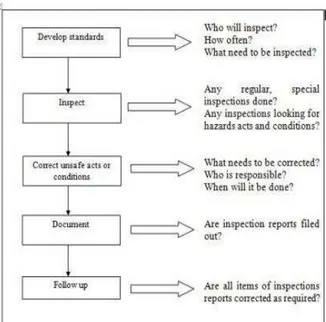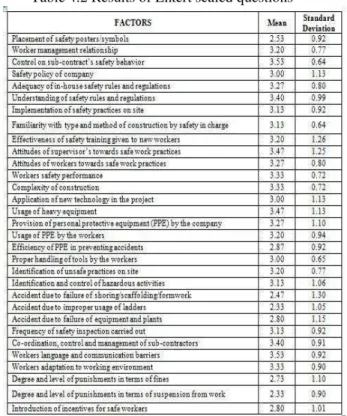T. Subramani
Int. Journal of Engineering Research and Applications
www.ijera.com
ISSN : 2248-9622, Vol. 4, Issue 6( Version 5), June 2014, pp.117-120
www.ijera.com 117 | P a g e
Safety Management Analysis In Construction Industry
T. Subramani
1, R. Lordsonmillar
21
Professor & Dean, Department of Civil Engineering, VMKV Engg. College, Vinayaka Missions University, Salem, India
2
PG Student of Construction Engineering and Management, Department of Civil Engineering, VMKV Engg. College, Vinayaka Missions University, Salem, India.
ABSTRACT
The Indian society and economy have suffered human and financial losses as a result of the poor safety record in the construction industry. The purpose of this study is to examine safety management in the construction industry. The study will collects data from general contractors, who are involved in major types of construction. Collected data include information regarding organizational safety policy, safety training, safety meetings, safety equipment, safety inspections, safety incentives and penalties, workers’ attitude towards safety, labor turnover rates and compliance with safety legislation. The study will also reveal several factors of poor safety management. Thus the paper will conclude by providing a set of recommendations and strategies to contractors for improving their safety performance.
KEYWORDS: Safety, Management, Analysis, Construction, Industry.
I.
INTRODUCTION
The significance of the construction industry to the economic and social life of the country is noteworthy. The industry needs much investment and involves various types of stakeholders and participants. From the point of view of safety the conditions normally encountered in the construction industry does not lend themselves to the degree of control, Possible in other industries where more stable conditions are generally obtained. The construction industry is usually very large, complex, and different from other industries. Hence it is prone to numerous health hazards.
II.
SAFETY
For many years safety professional have been aware that the majority of workplace accidents are triggered by unsafe behaviors, and that their control is one of the keys to successful accident prevention. However, many organizations, even those companies with low accident rate have been frustrated by their inability to control unsafe acts.
2.1 Importance of Safety in Construction
The construction industry has traditionally been considered as a hazardous occupation due to the high incidence of occupational injuries and fatal accidents. The number of fatal occupational accidents in construction all users the world is not easy to quantify, as information on this issue is not available for most countries. The outlay on construction in successive live year plans of India has been in the range of 36% to 50%.
2.2 Need for Safety Management
The construction industry has some special features which have a direct bearing on the accident potential. In this trade the pattern of work is ever changing. The operations and physical circumstances change constantly unlike in the factories where the process, the method and the operations are generally respective. Timings and schedules vary considerably from place to place. The most important changing factor the change of men themselves. The inherent nature of construction jobs combined with the above factors make this industry as one with accident risks.
2.3 Safety Clauses In Contract Documents
All Contract documents signed by the Owner and contractor contains various safety clauses wherein the contractor is obligated to make Provisions for the safety of men and structure and the consequences for failure to do so. The contractor is already mandated by law to comply with state and national regulations. The owner has to demand that the contractor document and implement the proper safety programs that will protect employees working on the job site. Owners sometimes hesitate and feel that they are interfering with the contractor’s say of doing business if they express concern over safety at a jobsite. In reality owners have the absolute right to mandate that a quality safety program be an important part of the selected contractor’s culture.
2.4 Safety Programme
The safety program of a Construction organization is a compact package which comprises a safety policy, safety department to implement the policy, and specially trained personnel to man it. The general safety inspection program that has to be followed in Construction site is shown in figure 2.1
T. Subramani
Int. Journal of Engineering Research and Applications
www.ijera.com
ISSN : 2248-9622, Vol. 4, Issue 6( Version 5), June 2014, pp.117-120
www.ijera.com 118 | P a g e
Fig 2.1 General Safety Inspection Program
III.
METHODOLOGY
The present study was conducted to establish to measure real time safety management performance on construction sites. The methodology adopted in this work is the collection of data by the method of survey. Surveying with a help of questionnaire was found to be most efficient based on the literature review conducted by the author and shown in figure.3.1
Fig.3.1.The methodology adopted in this work
3.1 Method of Analysis
SPSS Statistics is a software package used for statistical analysis. It is now officially named "IBM SPSS Statistics". SPSS Statistics (originally, Statistical Package for the Social Sciences, later modified to read Statistical Product and Service Solutions) was released in its first version in 1968 after being developed by Norman H. Nie, Dale H. Bent, and C. Hadlai Hull. SPSS is among the most widely used programs for statistical analysis in social science. It is used by market researchers, health
researchers, survey companies, government, education researchers, marketing organizations and others.
IV.
RESULT AND DISCUSSION
The questionnaire was distributed among twenty five companies mostly around Chennai. Totally Fifteen questionnaires returned us on date. The response rate was (60%).The percentage of companies that had participated in the survey are shown in the table 4.1
Table 4.1 Distribution of questionnaire
Totally for twenty five companies the questionnaires were given, out of which fifteen had an effective reply. Thus the response rate is 72% which is considered a good response in this type of survey. All the questionnaire survey was done from project manager or project engineer, site engineer of the project at the construction site. In the Fifteen questionnaires, there are 7 project managers, 6 site engineers and 2 design engineers are answered the questionnaire. In some cases, consultant gave the answers on behalf of their clients, both from the owner and the contractor side. Even email reply was accepted since it was difficult to get the direct one to one meeting with the Project managers. The percentage of safety investment that was made by the companies is less and not defined clearly. The general types of accident that commonly occur in construction site as observed by the respondents are stated below:
1. Falling from height.
2. Failure of temporary structures. 3. Fall of objects.
4. Hit by object. 5. Electrocution 6. Slippage.
7. Caught in between 8. Collapse.
T. Subramani
Int. Journal of Engineering Research and Applications
www.ijera.com
ISSN : 2248-9622, Vol. 4, Issue 6( Version 5), June 2014, pp.117-120
www.ijera.com 119 | P a g e
thousand rupees. Out of the fifteen companies surveyed four companies face legal suits for the cause of accident. Bar chart for surveying results as shown figure 4.1
Figure 4.1 Bar chart for survey results
Most of the companies that take part in the survey have a separate environment health and safety (EHS) document. But the safety provisions that are recommended in the EHS document are not implemented in construction sites.
The results of the Likert scaled questions are shown in Table 4.2 the mean value of all the factors that affect construction site safety vary between 2.33 to 3.53, which emphasis that in the whole of the companies that was surveyed the safety features are between low and high level. Out of the thirty one factors considered three factors were ranked as very high, ten factors as high, fourteen factors as medium and four factors as low effect with respect to safety. The coordination and control of sub contactor, control on sub contractor’s safety behavior and the provision of personal protective equipment by the company were ranked as top three factors that affect construction safety with an average mean of 3.53, 3.47 and 3.40 respectively. Results of Likerts scaled questions in given below the table 4.2.
Table 4.2 Results of Likert scaled questions
This booklet has been prepared based on the provisions of “BUILDING AND OTHER CONSTRUCTION WORKERS (REGULATION OF EMPLOYMENT AND CONDITIONS OF SERVICE) RULES, 1996” The booklet has been prepared for possible implementation of required safety measures in construction sites.
The Act has been made applicable to even small establishments employing 10 workers in any building and other construction work.
V.
SAFETY COMMITTEES
Every establishment wherein 500 or more building workers are ordinarily employed, there shall be a safety committee constituted by the employer which shall be represented by equal number of representatives of employer and the building workers employed in such establishment
The main functions of the safety committee, shall be, 1. To identify probable cases of accident and
safe practice in building or other construction work and to suggest remedial measures.
2. To stimulate interest of employees and building workers in safety by organizing safety weeks, safety competitions, talks and film shows on safety, preparing posters or taking similar other measures as and when required or as necessary.
T. Subramani
Int. Journal of Engineering Research and Applications
www.ijera.com
ISSN : 2248-9622, Vol. 4, Issue 6( Version 5), June 2014, pp.117-120
www.ijera.com 120 | P a g e
including first aid, medical and welfare facilities.
4. To look into the health hazards associated with handling different types of explosives, chemicals and other construction materials and to suggest remedial measures including use of proper personal protective equipment.
VI.
CONCLUSION
The work environments in construction activities are generally more hazardous, than other industries due to the use of heavy equipment, dangerous tools, and hazardous materials, all of which increase the potential for serious accidents and injuries. Therefore, it is evident that a focused dedication inwards safety is needed from construction at all levels. It can be inferred from the survey data that safety managers have the opportunity to influence and enhance the sense of safety and the quality of the work environment. Owners of large projects can more actively participate in construction safety management in each stage of project execution including project design contract selection, contract development, the construction phase, selecting safe contractors, and developing the safety culture on the projects through safety training and safely recognition programs.
REFERENCES
[1]. Amr A.G.Hassanein and Ragaa S.Hanna(2008), “Safety Performance in the
Egyptian Construction” Journal of
Construction Engineering and Management,
Vol. 134, No. 6, June 1, ASCE, pp 451-455. [2]. Dayana.B Costa; Carlos T.Formoso;
Michail Kagio gloa; Luis F. Alarcon; and Carlos. H.Carldas,(2006)”Benchmarking Initiatives in the Construction Industry:
Lessons Learned and Improvement
Opportunities” Journal of Management in
Engineering, Vol. 22 , No.4,October
1,2006.ASCE,158-167.
[3]. Gregory Carter and Simon D. Smith (2006)
“Safety Hazard Identification on
Construction Project” Journal of
Construction Engineering and Management,
Vol.132,No. 2, February 1,2006 ASCE,197-205.
[4]. Jimmie Hinze and Xinyu Huang and (2006) “Owner’s role in construction safety”
journal of construction engineering and
management ,Vol.132,No.2,February 1
2006.ASCE,164-173.
[5]. Kin Dorji and Bonaventura H. W. Hadikusumo(2006) “Safety Management Practices in the Bhutanese Construction
Industry” Journal of Construction in
Developing Countries, Vol. 11, No. 2, 2006.
[6]. Michacl Toole.P.E (2005)”Increasing Engineer Role in Construction Safety:
Opportunities and Barries” Journal of
Professional Issues in Engineering,Vol.
131,No.3,July 1,2005,ASCE, 199-207. [7]. Mohammad S. El-Mashaleh, Bashar M.
Al-Smadi , Khalied H. Hyari and Shaher M. Rababeh (2010)”Safety Management in the
Jordanian Construction Industry” Jordan
Journal of Civil Engineering, Volume 4,
No. 1, 2010.
[8]. Piia Tint, Õnnela Paas, Karin Reinhold
(2010)” Cost-Effectiveness of Safety
Measures in Enterprises”ISSN 1392 – 2785
Inzinerine Ekonomika-Engineering
Economics, 2010, 21(5), 485-492.
[9]. Rafiq M.Choudhry; Dongping Fang; and Sherif Mohamed(2009), “Developing a
model of Construction Safety culture”,
Journal Construction Engineering and
management ,Volume 23, No. 4, October 1,

